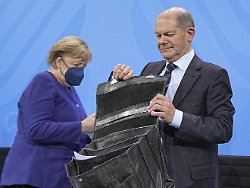Wednesday November 24th 2021
Eight weeks of your choice agreed
Traffic light parties present coalition agreement
In the afternoon the time has come: the SPD, Greens and FDP want to present their coalition agreement. This means that the three parties have reached a milestone: the first traffic light coalition should be in place at the federal level by Christmas. The distribution of the ministerial posts will also be announced.
The SPD, Greens and FDP want to present their coalition agreement for a joint federal government today. The three parties unanimously invited to a press conference at 3 p.m. in Berlin. A good eight weeks after the federal election, details of the cooperation that have so far been treated confidentially between the parties should become public.
Today, Wednesday, the main round of negotiations of the three parties will hold their final session. Afterwards, the party leaders and chancellor candidate Olaf Scholz will present the coalition agreement negotiated over the past few weeks. The contents of the agreement and the proposed cabinet list have so far been largely kept confidential.
The coalition negotiations began on October 21, after the three traffic light parties had previously laid the foundation stone for them in explorations. They were led in a main negotiating group made up of six high-ranking representatives from each party and in 22 working groups. In these, the politicians of the parties negotiated the details of the coalition agreement.
A coalition agreement must be approved by party congresses for the SPD and FDP and a member survey for the Greens. The previous Finance Minister, Olaf Scholz, is to be elected Chancellor in the Bundestag during St. Nicholas Week. After 16 years, this ends the era of Chancellor Angela Merkel, who did not run again in the federal election on September 26th.
First meeting planned for December 8th
In an exploratory paper, the SPD, the Greens and the FDP had already made some “preliminary determinations” and cleared away some issues. In it they wrote “a comprehensive renewal of our country” and “a new departure” for Germany in order to cope with major challenges such as climate change, digitization, securing prosperity and social cohesion.
Probably in consideration of the election promises of the FDP, it was agreed that no new taxes on assets would be introduced and taxes such as income tax, company tax or value added tax would not be increased. In the first year of a traffic light coalition, the statutory minimum wage is to be increased to twelve euros per hour. This was a central election promise of the SPD. The voting age for Bundestag and European elections is to be reduced from 18 to 16 years.
In order to meet the climate protection goals, the paper also stipulated that the phase-out from coal-fired power generation should be accelerated and, if possible, brought forward to 2030. So far, the coal phase-out is planned by 2038 at the latest. A general speed limit on motorways, as demanded by the Greens, should not come. On the subject of migration, it was agreed to speed up asylum procedures, family reunification procedures and returns. Legal access routes to Germany are to be created.
According to the usual rhythm of Bundestag weeks, the plenum would meet for the first time on December 8th during St. Should the chancellor election then take place, 73 days would have passed since the federal election. For comparison: after the 2017 election, it took 171 days to form a government – more than ever before. Four years earlier it had been 86 days. In contrast, the first and second red-green federal government led by Chancellor Gerhard Schröder in 1998 and 2002 each came about in just 30 days.
